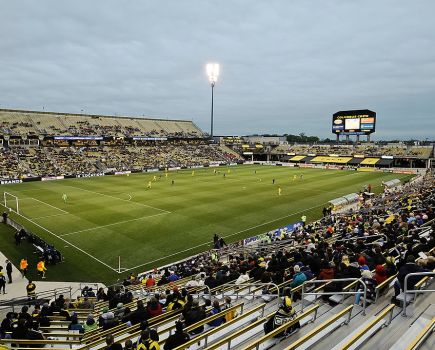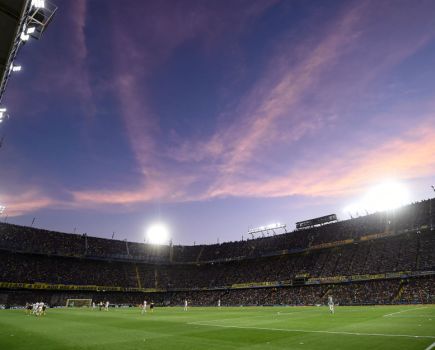AMSTERDAM
 As cosmopolitan as the city they represent, Ajax are a school of footballing excellence.
As cosmopolitan as the city they represent, Ajax are a school of footballing excellence.
A club branded by the famous thick red stripe running down their white shirts – from which three generations of star pupils have emerged to make their mark and win European silverware: the Ajax of Johan Cruyff of the 1970s; the Ajax of Marco Van Basten (with Cruyff as coach) of the 1980s; and Louis Van Gaal’s young Ajax of the 1990s, who heralded a new era with the opening of the futuristic Amsterdam ArenA in 1996.
Today’s stadium is a world away from the neighbourhood feel of the club’s former home of De Meer, where club icon Cruyff was raised. As a boy, he lived nearby and his mother used to take in the club’s laundry.
In the early amateur days, the city could boast a handful of top-flight clubs in the then-modest Dutch league. RAP Amsterdam won five league titles in the 1890s, while three cross-town rivals – Blauw Wit, De Volewijckers and DWS – merged to form FC Amsterdam in the 1970s and reached the quarter-finals of the 1974-75 UEFA Cup, beating Internazionale on route.
Now, however, Ajax are Amsterdam’s flagship club and when they win a trophy the whole city turns out in celebration on the Leidseplein. It was at the Cafe Oost Indie, on the nearby canal-side Kalverstraat, that a group of local businessmen met to form Ajax, on March 18, 1900. The new club enjoyed reasonable early success, notching up pre-war title wins under English coach Jack Reynolds at the modest De Meer stadium.
But it wasn’t until the mid-1960s that the club really took off.
Coached by disciplined tactician Rinus Michels, Ajax played in an adventurous 4-2-4 formation, based around teenage prodigy Cruyff and swift winger Piet Keizer. Although they won three Dutch titles in a row, it was a 5-1 thumping of Liverpool in the European Cup of 1966-67 that really made people sit up and take notice.
Surrounded by Horst Blankenburg, Ruud Krol, Johan Neeskens and Gerrie Muhren, Cruyff shone like few others and a European Cup Final defeat to Milan in 1969, was avenged at Wembley two years later with a 2-0 win over Panathinaikos.
With Romanian coach Stefan Kovacs taking over the helm, Ajax adopted “Total Football”, a fluid 4-3-3 system in which all outfield players were interchangeable, team-mates anticipating runs from deep in defence, not least by the attacking sweeper. The conductor was Cruyff and Ajax dominated the European Cup for two more seasons, beating Inter and Juventus in the Finals of 1972 and 1973.
Dip in form
When Cruyff and Neeskens headed for Spain the following season, Ajax’s form dipped – until the arrival of 17-year-old striker Van Basten. With Cruyff back as coach, Van Basten helped Ajax to the European Cup-winners Cup in 1987 before leaving for Italy. Poor league form also saw Cruyff depart, though Ajax did make it through to another Cup-winners Cup Final in 1988.
Under Leo Beenhakker, Ajax struggled to match a dominant PSV Eindhoven and it took the more adventurous Louis Van Gaal – who had been his assistant – for Ajax to find their old touch. A UEFA Cup win in 1992 featured the phenomenal talents of Dennis Bergkamp, who was later replaced by Finland striker Jari Litmanen.
A new young side nurtured at the Ajax Academy came to the fore under Van Gaal. With the return of 1987 veteran Frank Rijkaard, Van Gaal’s youngsters swept to Champions League glory in 1995, with a 1-0 win over Milan in the Final courtesy of 19-year-old Patrick Kluivert.
The team soon broke up, first Clarence Seedorf going, then Edgar Davids and Finidi George leaving a year later after Ajax again made the Final, only to lose to Juventus on penalties in 1996. Marc Overmars, the De Boer brothers and goalkeeper Edwin Van der Sar also departed and Ajax started to become known as a selling club. After Van Gaal went to Spain, the club suffered a couple of wayward years.
Once Ronald Koeman took over as coach in 2002, Ajax won the double thanks to Romanian captain Cristian Chivu and an impressive young Rafael Van der Vaart. A creditable Champions League run to the quarter-final in 2002-03 ended with an injury-time winner by eventual victors Milan but proved a valuable shop window for Mido and Zlatan Ibrahimovic.
The further sales of young talents such as Wesley Sneijder, Ryan Babel and, later, Klaas-Jan Huntelaar, attracted criticism, though the arrival of Luis Suarez brought a prolific goalscorer to the ArenA.
When club legend Van Basten handed the coaching reins over to Martin Jol this season, one of Jol’s first moves was to make Suarez captain. The reward? Progress in the Europa League, a 5-1 win over bitter rivals Feyenoord – and early talk of a league title for the first time in five long years.
Stadiums
1 Amsterdam ArenA
Opened in 1996 in the formerly neglected district of Bijlmer, the 51,000-capacity stadium with its retractable roof hosted the 1998 Champions League Final and several European Championship games in 2000.
2 Olympic Stadium
Built for the 1928 summer Games, the 31,600 capacity was later increased to 64,000 and the ground was used by Ajax for European games until the Amsterdam ArenA was completed. Now home to a museum – the Olympic Experience Amsterdam – it is no longer used for football.
Survival Guide
Daytime entertainment








